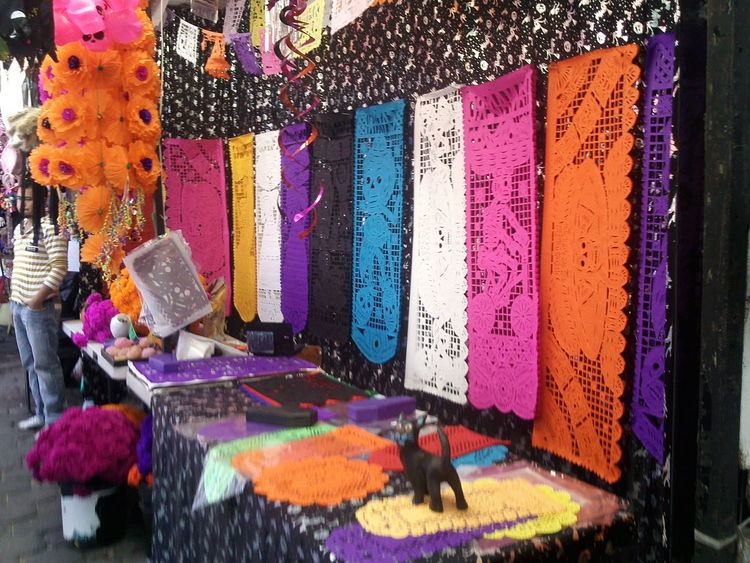 | ||
Papel picado ("perforated paper", literally "pecked paper") is a decorative craft made out of paper cut into elaborate designs. It is considered a Mexican folk art. The designs are commonly cut from tissue paper using a guide and small chisels, creating as many as forty banners at a time. Papel picado can also be made by folding tissue paper and using small, sharp scissors. Common themes include birds, floral designs, and skeletons. They are commonly displayed for both secular and religious occasions, such as Easter, Christmas, the Day of the Dead, as well as during weddings, quinceañeras, baptisms, and christenings. In Mexico, papel picado is especially incorporated into altars during the Day of the Dead.
Contents
Origins
Papel picado is similar to Chinese paper cutting (which originated in China during the sixth century), called 'jianzhi' (剪紙 or "cut paper"). The two crafts are not exactly the same, as the Chinese version was cut using scissors or knives, while the Mexican form is chiseled. In Mexico, during the middle of the nineteenth century, people were forced to buy products from hacienda stores, where they encountered tissue paper.
During the Aztec times, Aztecs used mulberry and fig tree bark to make a rough paper called "Amatl". When tissue paper became available, artisans usually layer 40 to 50 layers of tissue and punch designs into them using "fierritos", a type of chisel.
San Salvador Huixcolotla
San Salvador Huixcolotla is a municipality in the Mexican state of Puebla and is considered the center of papel picado. It is known for having a large community of craftsman who produce high quality papel picado.
In Huixcolotla, papel picado is primarily produced for the celebrations surrounding the Day of the Dead. Over time, the tool used to make papel picado has changed from scissors to chisels because of the greater precision and detailing they allow. Traditionally, the art of making papel picado has been passed from generation to generation. Around 1930, the art spread from Huixcolota to other parts of Mexico such as Puebla and Tlaxcala. Sometime in the 1960s, papel picado spread to Mexico City and from there to the United States and Europe.
Production
Traditionally, papel picado is made entirely by hand.
The first step is to draw out the design on paper and then cover the paper with transparent plastic. This will protect the original drawing. In order to produce multiple copies at once, fifty to one hundred sheets of China paper are stacked and then stapled together. Using multiple chisels with differently shaped tips, the artist cuts out pieces of the paper from the stack. This allows the carving of many copies of a design at one time.
The stack is then separated, with each sheet of paper being a papel picado. Each sheet is identical to all the others in the stack. Papel picados (or "banderitas") are typically hung on strings or attached to wooden dowels.
Cultural significance
The Ministry of Tourism and Culture in Mexico officially recognizes and supports the art of papel picado. In 1998, the governor of the state of Puebla decreed that the style of papel picado produced in San Salvador Huixcolota is part of the 'Cultural Heritage of the State of Puebla (Patrimonio Cultural del Estado de Puebla).
